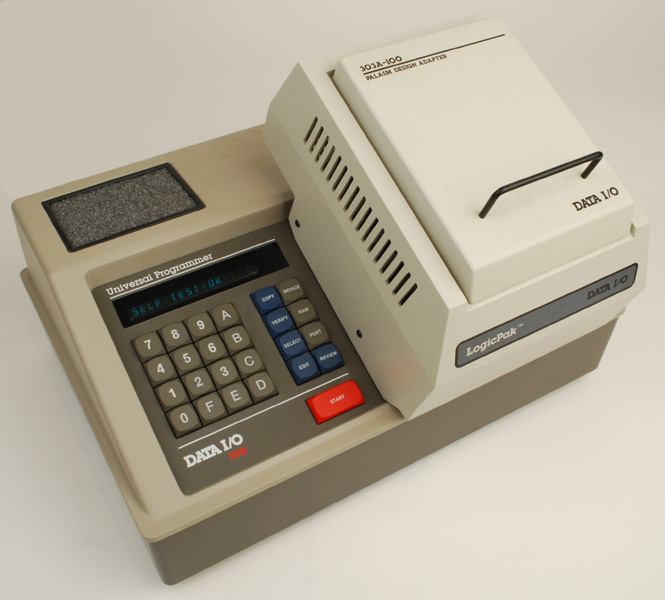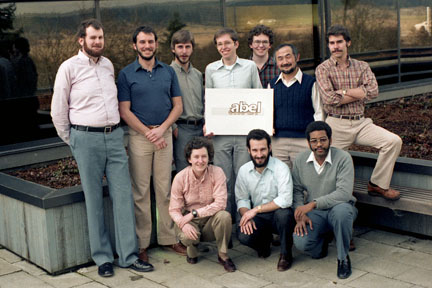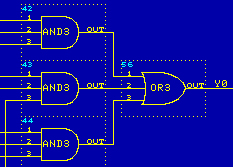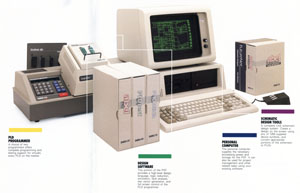
I had to good fortune of seeing programmable logic devices (PLDs) evolve from a niche market to a mainstream product. PLDs were commercially introduced in 1975 but really took off in the 1980s. I was a founding member of the team that developed ABEL, a program at allowed engineers to specify and simulate PLDs. Introduced in April 1984, ABEL was sold until 2007. Here is my collection of documents on the development of ABEL.
In March 1981 Data I/O formed a small R&D group headed
by Vic Belmondo. It was staffed by three new hires, Michael Holley, Keith
Miller and Russ dePina. Data I/O
was developing new programmer that would handle all Programmable Logic Devices (PLD).
This system included two Logic Design programs in ROM, PALASM for MMI PALs and
IFL for Signetics FPLAs. Russ dePina was tasked with specifying a Logic
Development Language that would handle all types of PLDs. In December 1981 Russ
wrote a five page report titled "Specification
For An Advanced Boolean Expression Language (ABEL)". This
is the earliest recorded use of term ABEL. Russ left Data I/O and joined AMD as
an Application Engineer before the ABEL project started.
Wayne Paulson
Programmable Logic Meeting Aug 13 1981
Vic Belmondo became the engineer manager in 1982. Here are some of Vic's memos from April 1982. MMI's
PALASM was the most popular PLD design software at that time. Signetics had a
low level design method call H&L. If
PALASM was a high level language,
H&L was machine level.
High Level Logic
Language - Apr 22 1982
Vic Belmondo to Steve Witten,
ABEL Language - May 25 1982
ABEL Task Force
Meeting - Apr 28 1982
Signetics was interested in a hardware description
language, like PALASM, for their FPLA products. Steve Witten, our semiconductor
company liaison, had been talking to Signetics about a possible joint
development of a FPLA language. Bill Smith of Signetics provided a language
specification.
Steve Witten Signetics Contract May 1982
(6 MB)
Steve Witten Signetics memo June 1 1982
Signetics IFL Development System Spec July 1982
Assisted Technology was a startup company in San Jose
that was developing a PLD design language that would become CUPL. Bill
Smith suggested that Data I/O visit Bob Osann, the president of Assisted
Technology. Steve Witten visited in July 1982.
Steve Witten's Bob Osann memo July 6
1982
Data I/O was a hardware company and the software they sold was embedded in
programmer. The Palasm Design Adapter on a LogicPak is shown on the right. There were a lot of discussions on how to proceed
with the ABEL project. Should Data I/O sell software that that ran on a general
propose computer? Should it be created in-house or contracted from an external
source?
Steve Witten Signetics memo Aug 10 1982
Sumner Averitt joined Data I/O around May 1982 as the Vice-President of Engineering. He decided that Data I/O needed an experienced software manager for the ABEL project. Dr. Kyu Lee, head of the Seattle University Software Engineering program, was recruited to lead the ABEL project. (I had taken a Pascal course from him in 1980.) Dr. Lee joined in July 1982. Russ dePina had joined AMD as an applications engineers by this time. Walter Bright, a mechanical engineer from Boeing, joined around this time. Walter brought to his interview a listing of the Pascal compiler he had written as a learning exercise. His home computer was a PDP11-03. (He would go on to write the first C++ compiler for the IBM PC.)
In the second half of 1982 the initial LogicPak software
was being revised. (It was 6800 assembly language.) Keith Miller was
the project lead, Walter Bright was improving the software structure to be more
like DEC Macro 11. Gerrit Barrere and Michael Holley were rewriting the terminal
interface and the PALASM software.
Source code title page.
Data I/O
PALASM Design Adapter main menu
PALASM
design example
PALASM Assemble and
Functional Test
Walter and Michael were also researching hardware
description languages. None of them were suitable for the target audience, types
of PLD devices or the existing personal computers. (Verilog had not be released
at this time.) Data I/O would announce the ABEL project to semiconductor
industry on December 16, 1982. AMD, Fairchild, MMI, National Semiconductor, Seeq
Technology and Signetics attended the presentation held at the AMD facility in
Sunnyvale CA. I gave view foil presentation explaining features of the ABEL
product with an expected delivery date of December 1983. (It was released in
April 1984.)
ABEL View Foils, Dec 16 1982 (Pre Power Point, created on an HP pen plotter with a custom program.)
ABEL Attendees Dec 16 1982
ABEL Attendees and Map Dec 16 1982
Kyu Lee Abel Trip Report Dec 16 1982
Vic Belmondo Trip Report Dec 1982
(5.2 MB)
We visited Assisted Technology and met with
Bob Osann and Art Aronson. They were
developing a product similar to ABEL that would be available in 1983. Some
people inside Data I/O were not confident we could complete ABEL so they
explored selling CUPL. Mike Mraz, our marketer, arranged a Beta evaluation
of CUPL in March 1983.
Assisted Technology Beta Mar 15 1983
CUPL Data Sheet 1983
Dr. Lee had an academic background so Walter Bright and Michael Holley did
an extensive technical literature search on hardware descriptions languages. The
first ABEL specification (with bibliography) was written in January 1983. A more
detailed specification and design document was completed in September 1983.
Logic synthesis was a popular topic at the annual Design Automation Conferences
(DAC) at the time. Doug Brown's (Tektronix) State-Machine Synthesizer had a significant influence on ABEL.
SMS used Antonin Svoboda's PRESTO algorithm for logic reduction. PRESTO was used
until ABEL 3.1 (1988) switched to the Espresso
algorithm developed at UC Berkeley by Richard Rudell.
ABEL Specification January 19, 1983
"A State-Machine Synthesizer - SMS", Douglas W. Brown (DAC, June 1981)
"Computer Hardware Description Languages", William M. vanCleemout (DAC, June 1979)
"Automatic PLA Synthesis from a DDL", S. Kang (DAC, June 1981)
"Universal Language for PLDs", Robert Osann (Wescon, September 1982)

Back row: Michael Holley, Mike Mraz, Gerrit Barrere, Walter Bright, Bjorn
Benson (now Freeman-Benson), Dr. Kyu Lee, David Pellerin
Front Row: Mary Bailey, Daniel Burrier, Charles Olivier
 The ABEL software consisted of six programs
that were called by a batch file. ABEL was divided into small programs because
of the memory limits of a 1983 vintage PC and for ease of development by
multiple engineers.
The ABEL software consisted of six programs
that were called by a batch file. ABEL was divided into small programs because
of the memory limits of a 1983 vintage PC and for ease of development by
multiple engineers.Walter Bright wrote the Parse and Transfor programs which converted the design into Boolean equations. Dave Pellerin was in the IT department and transferred into the ABEL group, he worked with Walter on Parse and Transfor. Mary Bailey wrote the Reduce programs which minimized the equations. Bjorn Benson wrote the Fusemap program which converted the sum-of-product equations into the bitmap of the selected PLD. Michael Holley wrote the Simulate program which ran a set of test vectors on the design. Charles Olivier wrote the Document program. Daniel Burrier was our technical writer. Kyu Lee was the project manager and Mike Mraz was our marketer. Gerrit Barrere did a variety of tasks from running the Beta program to posing for the first ABEL publicity photo.
All of the programs were functional by October 1983 and the first Beta went to semiconductors companies and Data I/O application
engineers in early December 1983. This was followed by a second beta in early 1984.
First complete run Oct 1983
ABEL Beta letter Nov 1983
ABEL Beta participants
Here are some marketing documents:
ABEL Product Description March 8, 1983
(6 MB)
ABEL Marketing Plan January 1984
Lloyd Hyden
Initial Build March 9, 1984
ABEL 1.1 Product Data Sheet October
1984
Here are two early articles on ABEL written by members of the design team.
Design News October 8, 1984
VLSI Design June 1985
ABEL was released in April 1984 and sold 962 copies by the end of 1984. In
initial price for the DOS version was $900 plus $100 per year support. Six thousand copies of ABEL had been sold by the end of 1987.
ABEL Five Year Anniversary Jan 1988
Several new people joined the team before the end of 1984.
Brian Durwood became the product marketer. Brenda French, Ngoc Nicholas, Denny
Siu, Steve Weil and others were software developers.
Here is a list of post release planed task:
ABEL Tasks September 4, 1984
 Data I/O acquired FutureNet, a Chatsworth, California maker
of schematic capture software, DASH. The deal was completed on November 28, 1984
for 2.16 million shares of Data I/O stock. The ABEL team was merged into
FutureNet but remained in Redmond WA. The first combined product was DASH-ABEL.
User could express a logic design with a schematic and merge it into ABEL. Dave
Pellerin and Brenda French were the engineers on the project.
Data I/O acquired FutureNet, a Chatsworth, California maker
of schematic capture software, DASH. The deal was completed on November 28, 1984
for 2.16 million shares of Data I/O stock. The ABEL team was merged into
FutureNet but remained in Redmond WA. The first combined product was DASH-ABEL.
User could express a logic design with a schematic and merge it into ABEL. Dave
Pellerin and Brenda French were the engineers on the project.
DASH-ABEL
brochure March 1985
We were located in an office park about a mile
south of the main Data I/O building. Due to a natural gas leak, we blew the roof
off one Thursday afternoon. We were back at work in new offices Monday morning.
Afternoon of Thursday June 13, 1985
Photos
Denny Sui and Francis Wang developed PLDTest, software that would
automatically generate test vectors that would verify the correct operation of
PLDs on a Data I/O programmer.
PLDTest
November 1985
PROMlink was the PC software that
controlled the programmer.
PROMlink
Brochure December 1986

A very successful marketing campaign was Data I/O's "Personal Silicon Foundry"
or "Concept To Silicon" beginning in August 1985. Data I/O provided the design
software and device programmer to allow an engineer to specify a design and
program the PLD in just a few hours. This supported virtually every programmable
logic device on the market.
Concept
To Silicon Advertisement August 1985
Concept
To Silicon Brochure August 1985
The FutureNet schematic capture software was written in
8086 assembly language for the IBM PC. Walter Bright and ??? ported the code to
C, a much more portable programming language.
Low cost schematic
editors, such as OrCAD, appeared on
the market in 1986 and sold for $500. The FutureNet DASH package was $5000. The FutureNet management in Chatsworth stared several
expensive projects about the time competition in schematic capture lowered their
sales. The Chatsworth office was closed at the end of 1987. The Redmond group
continued on.
FutureNet phone list
1989